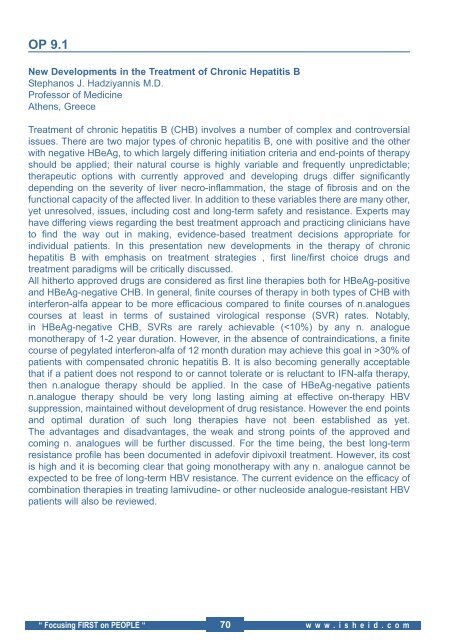final program.qxd - Parallels Plesk Panel
final program.qxd - Parallels Plesk Panel
final program.qxd - Parallels Plesk Panel
You also want an ePaper? Increase the reach of your titles
YUMPU automatically turns print PDFs into web optimized ePapers that Google loves.
OP 9.1<br />
New Developments in the Treatment of Chronic Hepatitis B<br />
Stephanos J. Hadziyannis M.D.<br />
Professor of Medicine<br />
Athens, Greece<br />
Treatment of chronic hepatitis B (CHB) involves a number of complex and controversial<br />
issues. There are two major types of chronic hepatitis B, one with positive and the other<br />
with negative HBeAg, to which largely differing initiation criteria and end-points of therapy<br />
should be applied; their natural course is highly variable and frequently unpredictable;<br />
therapeutic options with currently approved and developing drugs differ significantly<br />
depending on the severity of liver necro-inflammation, the stage of fibrosis and on the<br />
functional capacity of the affected liver. In addition to these variables there are many other,<br />
yet unresolved, issues, including cost and long-term safety and resistance. Experts may<br />
have differing views regarding the best treatment approach and practicing clinicians have<br />
to find the way out in making, evidence-based treatment decisions appropriate for<br />
individual patients. In this presentation new developments in the therapy of chronic<br />
hepatitis B with emphasis on treatment strategies , first line/first choice drugs and<br />
treatment paradigms will be critically discussed.<br />
All hitherto approved drugs are considered as first line therapies both for HBeAg-positive<br />
and HBeAg-negative CHB. In general, finite courses of therapy in both types of CHB with<br />
interferon-alfa appear to be more efficacious compared to finite courses of n.analogues<br />
courses at least in terms of sustained virological response (SVR) rates. Notably,<br />
in HBeAg-negative CHB, SVRs are rarely achievable (30% of<br />
patients with compensated chronic hepatitis B. It is also becoming generally acceptable<br />
that if a patient does not respond to or cannot tolerate or is reluctant to IFN-alfa therapy,<br />
then n.analogue therapy should be applied. In the case of HBeAg-negative patients<br />
n.analogue therapy should be very long lasting aiming at effective on-therapy HBV<br />
suppression, maintained without development of drug resistance. However the end points<br />
and optimal duration of such long therapies have not been established as yet.<br />
The advantages and disadvantages, the weak and strong points of the approved and<br />
coming n. analogues will be further discussed. For the time being, the best long-term<br />
resistance profile has been documented in adefovir dipivoxil treatment. However, its cost<br />
is high and it is becoming clear that going monotherapy with any n. analogue cannot be<br />
expected to be free of long-term HBV resistance. The current evidence on the efficacy of<br />
combination therapies in treating lamivudine- or other nucleoside analogue-resistant HBV<br />
patients will also be reviewed.<br />
“ Focusing FIRST on PEOPLE “ 70 w w w . i s h e i d . c o m
















